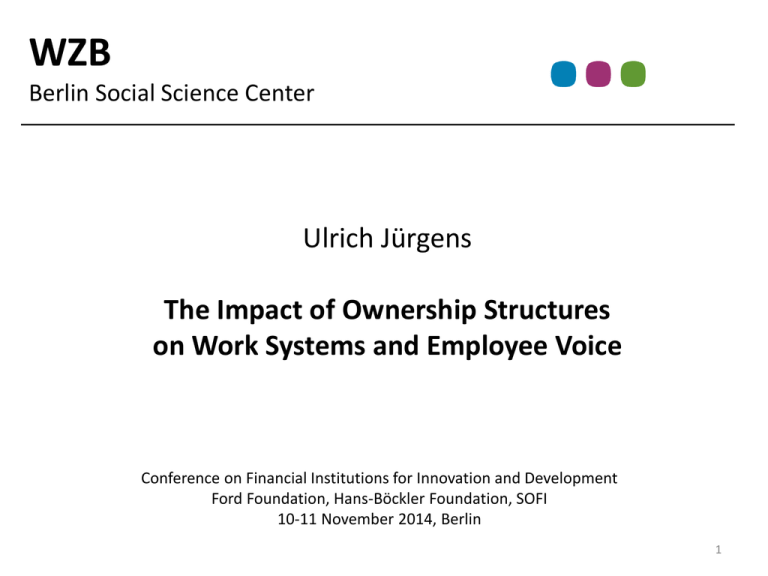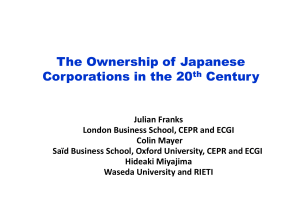Presentation - Financial Institutions for Innovation and Development
advertisement

WZB Berlin Social Science Center Ulrich Jürgens The Impact of Ownership Structures on Work Systems and Employee Voice Conference on Financial Institutions for Innovation and Development Ford Foundation, Hans-Böckler Foundation, SOFI 10-11 November 2014, Berlin 1 Central Question and Underlying Research Central question: • How do different arrangements of corporate governance impact the development of work systems, in particular forms of work organization that favour high-road jobs? Research project (together with Inge Lippert) carried out 2009/2010 financed by the Hans-Böckler-Foundation Company level interviews in the automotive supplier industry. Three companies each in Germany, Sweden, USA. Theory perspective: Path theory, Varieties of Capitalism Publications: Lippert, Inge, Tony Huzzard, Ulrich Jürgens and William Lazonick (2014): Corporate Governance, Employee Voice, and Work Organizations: Sustaining high-road jobs in the automotive supply industry, Oxford University Press. 2 Three Types of Companies • Capital market buffered companies (Type I): Stable (private) capital, little dependency on capital markets • Capital market exposed companies (Type II): High dispersion of share ownership, predominance of institutional investors, high dependency on capital markets for financing • Private Equity controlled companies (Type III): Short-term oriented capital, close control by financial investors 3 The Company Sample Country Company (anonymous) Employees (2010) Form of Governance Germany Ger_Insider 47.000 Capital market buffered, foundation company 7 Ger_Stock 10.000 Market-listed stock corporation, Distributed capital stock 6 Ger_Equity 3.900 Private Equity-financed 2 Sweden_Insider 44.000 Capital market buffered, company of the Wallenberg-family 5 Sweden_Stock 43.000 Market-listed stock corporation, Distributed capital stock 5 Sweden_Equity 6.000 (before crisis), 600 (after crisis) Private Equity-financed 5 US_Insider 15.000 Capital market buffered, ESOP-company 8 US_Stock 80.000 (1998), 24.000 Market-listed stock corporation, Distributed capital stock 8 US_Equity 61.000 Private Equity - financed 5 Sweden USA Number of interviews 4 Findings: Capital Market buffered (Type I) Companies No change of path in the Corporate Governance System, endogenously driven change • High continuity of corporate governance actors (owners, management, labor representatives); • Resources are used for reinvestment. Investment in long-term skill development of employees was not reduced. • Management remuneration and bonuses lower than in listed stock companies and based on long-term development criteria. 5 Findings: Capital Market buffered Companies - continued … but isomorphous adaptation processes • The companies adopted strategies and modes of behavior which are similar to the ones of type II companies: Increased profitability expectations and use of financial indicators (EBIT and ROCE) also used by market-listed companies. Incentive systems (systems of management payment) are adapted to the systems of market-listed companies. Adoption of so called „best practice“ strategies (off-shoring into lowwage countries, benchmarking with ‚best practices‘, restructuring of value-added chains etc.) 6 Corporate Governance System in a German foundation-owned Company IG Metall Selection Foundation Holding Company (15 Management Representatives from cooperating Supplier Companies) 3-6% Dividend Supervisory Board (is subject to Participation Law, 16 Members) Performance Requirements Strategical Development Central Works Council Management (40 Members) WC WC WC WC WC 20 Local Works Council 7 Lippert, I. and U. Jürgens (2012): Corporate Governance und Arbeitnehmerbeteiligung in den Spielarten des Kapitalismus: Pfade der Unternehmensentwicklung in der Automobilzulieferindustrie in Deutschland, Schweden und den USA, Hans-Böckler-Stiftung, Edition Sigma, Berlin: p. 91. Summary of Findings on individual Type I Companies Interest representation Work systems Ger_Insider Strong system of employee interest representation No subordination to financial goals; „cooperative countervailing power“; „negotiated shareholder value“ Not a pioneer in work system social innovation, no team work because of opposing interests Qualification policy on the „high road“ High job security standards for employees Sweden_Insider Strong system of employee interest representation Strong „voice“ on the supervisory board Weekly negotiation rounds International solidarity („World Union Council“) Pioneer in „good work“ principles System of competency development and „Knowledge based pay system“ Employment security through work-time flexibility and a “multi-knowledge“ approach US_Insider Originally strong labor voice (no union) and empowerment - weakening „Veto-right“ of the employee shareholders as poison pill against hostile takeovers Strong teamwork (SDWT) - continued Qualification on the „high road“ (own university) – continued Commitment to long-term job security 8 Findings: Capital Market exposed (Type II) Companies Changes of path and transformation with new strategies, new goals and new actors. • Increasingly „impatient capital“ in the ownership structures. The shareholders are mainly institutional investors. • Radical restructuring measures: closure of plants in peripheral areas, opening of new plants in core areas of competence, aggressive strategies concerning relocation to low-cost countries, thereby undermining the model of long-term employment, also in the European companies. • The goal of shareholder-value maximization is accompanied by shareholder friendly policies aiming at a redistribution of ressources in favour of the shareholders. • The change of course towards a shareholder- value model went along with complete exchange of personnel in management and of corporate governance institutions. High bonuses induce the management to prioritize short-term shareholder interests. 9 Summary of Findings on individual Type II Companies Interest representation Work systems Ger_stock Differentiated and established system of co-determination „Concession Bargaining“ (employment security commitment as a means to enforce cost reduction) Shareholder value orientation weakens co-determination practices No roll back of “qualified team work“ Skill development on the „high road“ Sweden_stock Considerable weakening of the system for the representation of union interests No representation of employees on the board Moves towards an adversarial model of industrial relations Pushing aside of „good work“ by Toyota production system Qualification on the „low road“ No committment to employment security (hire and fire) US_stock Strengthening of labor voice through a crisis deal New strategic partnership with UAW A union representative in the board Participation of unions on the local level (Co-Management) Strengthening of team orientation through HPWP with taylorist features Investment in skills in order to improve product quality New standards of employment security (UAW has to agree to layoffs, encouragement of union organized plants etc.) 10 Findings: Private Equity financed (Type III) Companies Abrupt change of path • Exchange of personnel in central management positions and in corporate governance institutions, determined by the private equity investor. • Development of a mid/long-term plan, describing goals and activities of the turnaround process. The implementation of the measures is evaluated by the investor. • Far reaching restructuring processes: in some cases even relocation of the entire production to low-wage countries and fast growth by acquisitions. • Measures to increase the cash flow, for example selling real estate and machinery which have to be rented back (expensively). 11 Summary of Findings on individual Type III Companies Interest representation Work systems Ger_equity Weakening of interest representation rights by reducing workforce to under 2000 employees Cooperative attitude towards interest representatives, but dominance of private equity goals Low impact of employee representatives in corporate governance Displacement of qualified team work and return to Taylorism Standardized production system with low qualified employees Qualification on the „low road“ Emplyoment security as an „instable compromise“ Sweden_equity Cooperative attitude towards interest representatives Weak employee representation on the board Rollback of „good work“ Qualification on the „low road“, incentives for specialization Low employment security, massive reduction of staff and wages because of insolvency US_equity Strategic avoidance of unions Long tradition of HRM policy competing with union organization Closure of plants with organized unions, opening of union free ones „manufacturing excellence“ based on team oriented production structures and employee involvement Reduction of participatory elements with crisis Reduction of costs via staff cuts (hire and fire) 12 General Findings The differences between the types of companies are bigger than the ones between nations. The positioning vis à vis capital markets is the central variable explaning different path developments. Instances of a re-alignment with the national model are observable in some cases (US_insider, Sweden_equity). The changes of CG in type II companies were however firmly established. Interactions between the elements of the institutional system are not just caused by changes in the ownership structure. They can also be caused by changes in the system of employee participation. In cases of weak interest representation the impact of financialization is clearly observable (private equity financed companies, Sweden_stock) A strong representation of worker interests however can countervail „low road“ developments (Ger_stock) 13 Capital market Strategic decisions National system Governance compromises Backup: Explanatory Model Path Continuity Corporate governance Employee participation Breaking Of path Change of path Work system High road/low road 14







